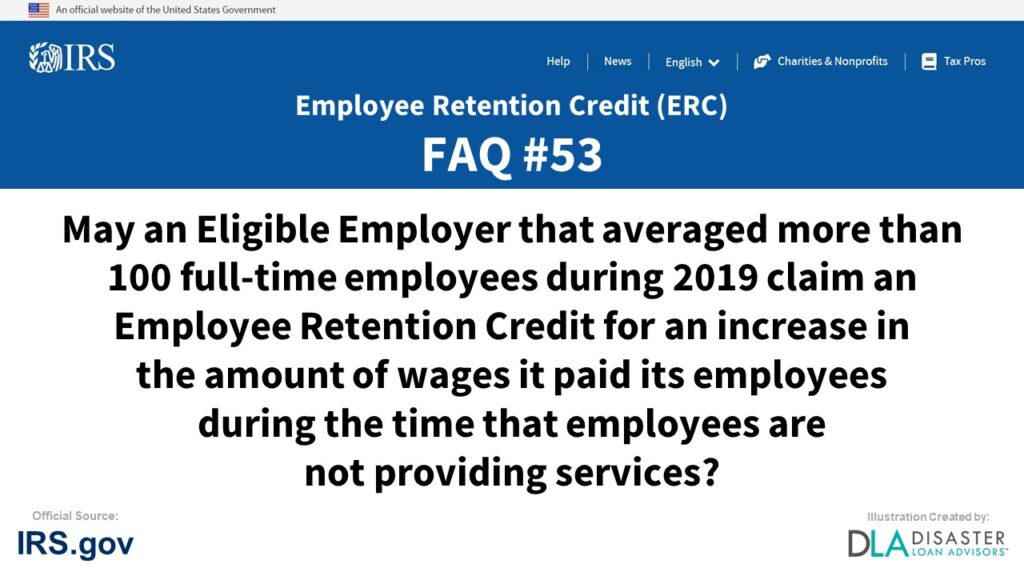
Frequently asked question #53 “May an Eligible Employer that averaged more than 100 full-time employees during 2019 claim an Employee Retention Credit for an increase in the amount of wages it paid its employees during the time that employees are not providing services?” under the Determining Qualified Wages section of FAQs: Employee Retention Credit under the CARES Act, provided by the IRS.gov to help business owners understand the ERC program. Information is below for the question #53 May an Eligible Employer that averaged more than 100 full-time employees during 2019 claim an Employee Retention Credit for an increase in the amount of wages it paid its employees during the time that employees are not providing services?
ERC Credit Frequently Asked Question #53:
COVID-19-Related Employee Retention Credits:
Determining Qualified Wages FAQs
53. May an Eligible Employer that averaged more than 100 full-time employees during 2019 claim an Employee Retention Credit for an increase in the amount of wages it paid its employees during the time that employees are not providing services?
No. For Eligible Employers that averaged more than 100 full-time employees during 2019, qualified wages paid to an employee may not exceed what the employee would have been paid for working an equivalent duration during the 30 days immediately preceding the commencement of the full or partial suspension of the operation of the trade or business or the first day of the calendar quarter in which the employer experienced a significant decline in gross receipts.
For a variable hour employee, the amount paid for working an equivalent duration during that 30-day period may be determined using any reasonable method. The method(s) that the Department of Labor has prescribed to determine the amount to pay an employee with an irregular schedule who is entitled to paid sick leave under the FFCRA would be considered reasonable for this purpose. For more information, see Department of Labor’s Temporary Rule: Paid Leave under the Families First Coronavirus Response Act.
Example: Employer S, a grocery store chain that averaged more than 100 full-time employees in 2019, is subject to a governmental order limiting store hours.
In response, Employer S has reduced the hours its employees work, but in order to incentivize those employees who continue to provide services, the employer increases the employees’ rate of pay by $1 an hour. Only the amounts paid to employees for time they are not providing services, and at the rate of pay in effect prior to the increase, would be considered qualified wages.
For more Internal Revenue Service (IRS) Department of the Treasury Employee Retention Credit (ERC) Determining Qualified Wages FAQs, visit the official IRS.gov tax website.
Conclusion and Summary on ERC Credit FAQ #53. May an Eligible Employer that averaged more than 100 full-time employees during 2019 claim an Employee Retention Credit for an increase in the amount of wages it paid its employees during the time that employees are not providing services?
The “May an Eligible Employer that averaged more than 100 full-time employees during 2019 claim an Employee Retention Credit for an increase in the amount of wages it paid its employees during the time that employees are not providing services?” is Frequently Asked Question #53 of many commonly asked questions small business owners are wondering about how to file the Employee Retention Tax Credit (ERTC). The IRS ERC Tax Credit program is a confusing and complex process to determine the correct ERC calculations your business qualifies for. Answers to “May an Eligible Employer that averaged more than 100 full-time employees during 2019 claim an Employee Retention Credit for an increase in the amount of wages it paid its employees during the time that employees are not providing services?” and filling out form 941-X may change slightly from frequently updated rules and regulations from the IRS. Leave a comment below if you have further questions on ERC Credit FAQ #53.
Help Completing / Filing / Claiming the Employee Retention Credit (ERC)
Receive Up to a $26,000 ERC Credit from the IRS Per Employee
Disaster Loan Advisors can assist your business with the complex and confusing Employee Retention Credit (ERC), Form 941-X, and the Employee Retention Tax Credit (ERTC) program.
Depending on eligibility, business owners and companies can receive up to $26,000 per employee based on the number of W2 employees you had on the payroll in 2020 and 2021.
The ERC / ERTC Tax Credit Program is a valuable IRS tax credit you can claim. This is money you have already paid to the IRS in payroll taxes for your W2 employees.
We DO NOT charge a percentage (%) of your ERC Refund like some companies are charging. Some ERC firms out there are charging upwards of 15% to 35% of your ERC refund!
Our professional ERC fee and pricing structure is very reasonable in comparison.
If you are looking for an ERC Company that believes in providing professional ERC Services and value, in exchange for a fair, reasonable, and ethical fee for the amount of work required, Disaster Loan Advisors is a good fit for you.
Schedule Your Free Employee Retention Credit Consultation to see what amount of employee retention tax credit your company qualifies for.
Cover Image Credit: Irs.gov / ERC FAQ / Disaster Loan Advisors
